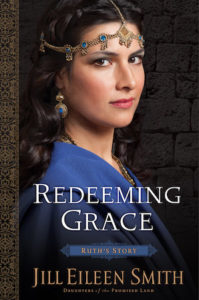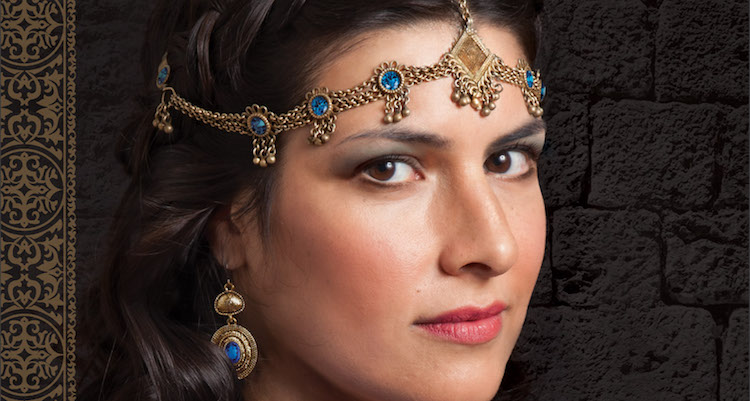Jill Eileen Smith has carved out her niche of biblical fiction over the years and now she is telling Ruth’s story in her novel Redeeming Grace: Ruth’s Story (Revell). It’s the third installment in her Daughters of the Promised Land series. In this interview, Jill explains her inspiration behind the series, what she learned while writing and also what we can expect for the finale of this series.
WHY DID YOU CHOOSE TO WRITE ABOUT RUTH?
I wanted to write about women who lived during the period of the Judges and Ruth fit that category. The beginning of her book starts out with, “In the days when the judges ruled there was a famine in the land…” I also think Ruth is a fascinating person. Her story is pretty well known and yet, is it? We are only given a little glimpse of the facts and some of the conversations, but scant little else. Pursuing her story was a challenge.
CAN YOU PLEASE PROVIDE A BRIEF SUMMARY OF REDEEMING GRACE?
 Redeeming Grace is taken from the book of Ruth in the Old Testament. While many people are familiar with this tale, I wanted to dig deeper into what life might have been like for Ruth in her homeland of Moab and during her ten years of marriage to her first husband. I also wanted to explore the thoughts of her mother-in-law, Naomi, as she followed her husband away from the Promised Land.
Redeeming Grace is taken from the book of Ruth in the Old Testament. While many people are familiar with this tale, I wanted to dig deeper into what life might have been like for Ruth in her homeland of Moab and during her ten years of marriage to her first husband. I also wanted to explore the thoughts of her mother-in-law, Naomi, as she followed her husband away from the Promised Land.
Redeeming Grace is a story of hardship, determination, obedience to God, loss and love. It is a tale of redemption on several levels and in the end a tender love story with a promising future.
IN REDEEMING GRACE, YOU USE THREE POINTS OF VIEW TO TELL THE STORY. PLEASE TELL US A LITTLE ABOUT THE CHARACTERS IN YOUR BOOK AND HOW YOU HAD TO CREATE A BACKSTORY FOR THESE INDIVIDUALS.
The story moves between Naomi’s, Ruth’s, and Boaz’s points of view. In Naomi we see much sorrow and loss. She is a woman whom I would consider a female Job.
In Boaz, I had to imagine much of his life, as the Bible doesn’t give us details before he met Ruth, but he surely didn’t live in obscurity. It would be expected that he had married, and perhaps had children because he is older than Ruth when they finally meet.
Ruth begins the story as a foreigner that has been raised to worship gods that the God of Israel forbids. So I had to imagine Ruth in her culture, what she lived with, what she loved or hated and I had to create a family for her before she married into Naomi’s lineage.
WHAT DID YOU LEARN ABOUT YOURSELF WHILE WRITING THIS BOOK?
Ruth’s story is so well known that I didn’t really give the book a lot of thought until I sat down to write it. But then I had to come up with backstories on each of the characters and delve into their possible mindset. And it struck me then that I related more to Naomi than to Ruth—not because I’m widowed (I’m not) or have lost children (I haven’t) but because of her age and status as a mother-in-law. And I wondered how I would have felt if my husband had decided to stop trusting God for our future and moved us to a foreign land rather than wait out the difficult circumstances in the land God had given to us.
I also had to put myself into Ruth’s character, so I was essentially playing the roles of both daughter-in-law and mother-in-law, of which I’ve been both. It was interesting to see life from two differing perspectives. Most of us probably relate to Ruth when we read Ruth’s story in Scripture, and because the book carries her name, we naturally think the story is hers. But I sensed, perhaps because I related more to her, that this was actually Naomi’s story. She is the one who suffered the greatest losses and ended up with the most joyous gains.
I will say, however, that I loved the relationship Naomi had with Ruth. Ruth’s devotion to Naomi went beyond the expected, even in her day. She could have returned, as Orpah did, to her mother’s house and married a man from Moab. I have to think Ruth’s choices were not only for Naomi but because she was in search of a better life with Israel and their God whom she was only beginning to know. Both women took great risks, and I admire that. If the time came for me to make risky choices because God said “go” or “do,” would I have the same kind of courage to follow where He leads?
WHAT FAITH MESSAGE DO YOU WANT READERS TO TAKE FROM REDEEMING GRACE?
 I think Ruth’s story in Scripture is an Old Testament look at the phenomenal grace of God. The idea that a foreigner could be accepted, grafted into the heritage of Israel is a bigger deal than we may realize. The people of Israel were chosen of God to be separate, to show the world what it looked like to worship a God they couldn’t see but who was mighty and powerful enough to have saved them from slavery in the land of Egypt.
I think Ruth’s story in Scripture is an Old Testament look at the phenomenal grace of God. The idea that a foreigner could be accepted, grafted into the heritage of Israel is a bigger deal than we may realize. The people of Israel were chosen of God to be separate, to show the world what it looked like to worship a God they couldn’t see but who was mighty and powerful enough to have saved them from slavery in the land of Egypt.
They were to be light to the darkness that people like Ruth lived with in her culture every day. Ruth knew a different kind of slavery—one to the gods of her people who required child sacrifice and other detestable practices that brought no true redemption or salvation from anything. Then we see Ruth meet Naomi and her family and she is introduced to this Creator God who wants her loyalty and obedience, but in return, He offers grace. Always, always grace. Not the sacrifice of her child but the offering of her heart. For her faith, she is counted among a handful of foreign women in the lineage of Jesus the Messiah. The story in Scripture is truly a picture of redeeming grace. I hope that also comes through in my historical retelling.


